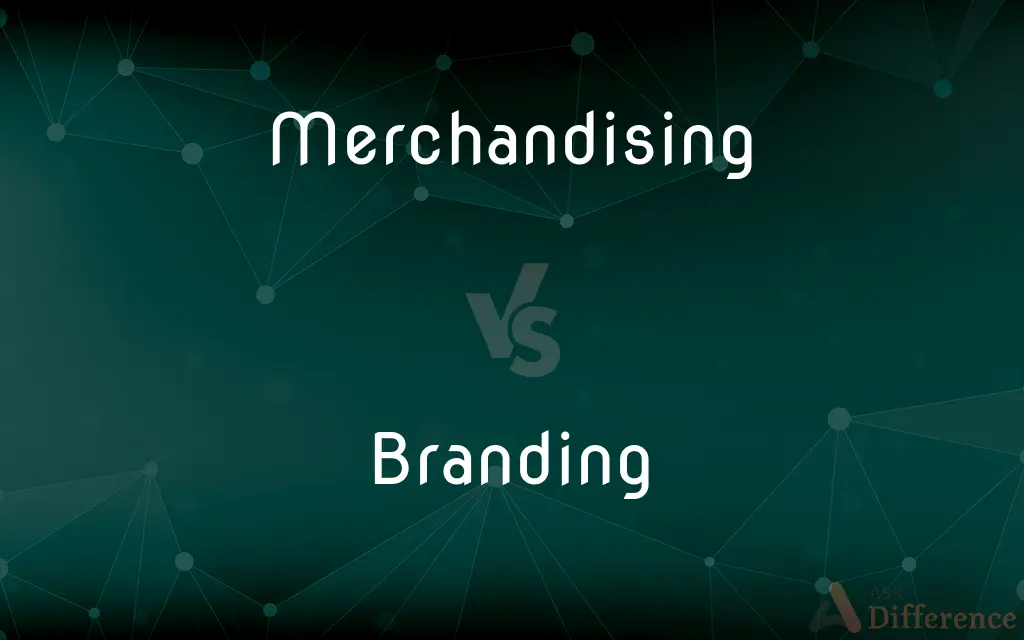Merchandising vs. Branding — What's the Difference?
By Tayyaba Rehman & Fiza Rafique — Updated on March 24, 2024
Merchandising focuses on promoting and selling products through strategic presentation and availability, while branding involves creating a unique identity and image for a product or company to build customer loyalty.

Difference Between Merchandising and Branding
Table of Contents
ADVERTISEMENT
Key Differences
Merchandising encompasses the tactics and strategies used to promote the sale of products, primarily through their presentation in retail environments. This includes the placement of products, pricing strategies, display techniques, and promotional activities aimed at stimulating purchases. On the other hand, branding is the process of developing a distinctive identity for a product, service, or company. This identity encompasses elements such as name, logo, design, and a consistent theme that aims to establish a presence in the consumer's mind and differentiate from competitors.
While merchandising is often about the immediate, tactical aspects of placing products in front of consumers in appealing ways, branding is about building a long-term relationship between the consumer and the product or company. Branding seeks to evoke emotional responses and create loyalty, thereby ensuring ongoing consumer engagement. In contrast, merchandising can be seen as more transactional, focusing on the conversion of interest to purchase at the point of sale.
Merchandising strategies can change frequently based on consumer trends, seasons, and sales data, allowing for flexibility in how products are presented to consumers. Branding, however, requires consistency over time to build and maintain brand recognition and loyalty. Although branding elements can evolve, they do so in a calculated manner that maintains the core identity and values of the brand.
Effective merchandising can lead to immediate sales increases by optimizing the retail environment, but without strong branding, it may not contribute to long-term customer retention. Conversely, strong branding can create a loyal customer base that repeatedly purchases products, but without effective merchandising, these products may not perform as well in competitive retail settings.
The success of merchandising often relies on understanding consumer behavior at the point of sale, including visual merchandising, pricing strategies, and promotional tactics. Branding success, however, is built on understanding the broader consumer psyche, including values, aspirations, and the desire for connection with the brand. This deeper connection is what can turn occasional buyers into lifelong customers.
ADVERTISEMENT
Comparison Chart
Focus
Promoting and selling products
Creating a unique identity and image
Key Elements
Product placement, pricing, displays, promotions
Name, logo, design, consistent theme
Objective
Stimulate immediate purchases
Build long-term customer loyalty
Strategy
Tactical, often varies
Strategic, requires consistency
Impact on Consumers
Encourages immediate purchase decisions
Fosters emotional connection and brand loyalty
Role in Retail
Enhances product visibility and appeal in-store
Influences consumer perception and choice beyond retail
Timeframe
Short-term, with frequent adjustments
Long-term, with careful evolution
Relationship with Consumer
Transactional
Emotional and relational
Compare with Definitions
Merchandising
The use of promotional activities and sales techniques to stimulate interest in a product.
Merchandising tactics during the holiday season include special discounts and bundled offers.
Branding
The process of creating a unique name and image for a product or service in the consumer's mind.
Their branding efforts have made them a household name.
Merchandising
The strategic placement of products within a store to maximize visibility and attractiveness.
The end-cap merchandising resulted in a noticeable uptick in sales.
Branding
The promotion of a particular product or company by means of advertising and distinctive design.
The company is known for its aggressive branding and marketing strategies.
Merchandising
The activity of promoting the sale of goods, especially by their presentation in retail outlets.
Effective merchandising can significantly increase product sales.
Branding
The set of attributes and values that a company aims to project to its customers.
Sustainability and innovation are key aspects of their branding.
Merchandising
The range of products offered for sale and how they are presented to customers.
The store revamped its merchandising, introducing dynamic displays.
Branding
The strategy of maintaining a consistent image and identity across all aspects of a company or product.
Their branding strategy involves a uniform color scheme and design across all platforms.
Merchandising
The practice of developing and offering branded products for sale as part of a marketing strategy.
Band T-shirts and caps are part of the group's merchandising efforts.
Branding
The use of a logo, symbol, or design to identify a company or its products uniquely.
The iconic swoosh logo is central to Nike's branding.
Merchandising
Merchandising is any practice which contributes to the sale of products to a retail consumer. At a retail in-store level, merchandising refers to displaying products that are for sale in a creative way that entices customers to purchase more items or products.
Branding
A trademark or distinctive name identifying a product, service, or organization.
Merchandising
The activity of promoting the sale of goods, especially by their presentation in retail outlets
Problems rooted in poor merchandising
Branding
A product or service so identified
Bought a popular brand of soap.
Merchandising
The promotion of merchandise sales, as by coordinating production and marketing and developing advertising, display, and sales strategies.
Branding
An association of positive qualities with a widely recognized name, as of a product line or celebrity
The company tried to improve its brand by donating money to charity.
Merchandising
The sale of merchandise in connection with an established brand, such as a sports team or a film.
Branding
A distinctive category; a particular kind
A brand of comedy that I do not care for.
Merchandising
Gerund of merchandise
Branding
A mark indicating identity or ownership, burned on the hide of an animal with a hot iron.
Merchandising
(archaic) Trade in merchandise.
Branding
A mark burned into a person's flesh, as to identify a convicted criminal or a slave.
Merchandising
The promotion of goods for sale in a store, especially through advertising, attractive displays, discounts, etc.; also (generally), the promotion of any goods or services for sale.
Branding
A mark burned into a person's flesh for ornamental or aesthetic purposes.
Merchandising
(specifically) The promotion of a film, music group, theatre production, etc., through the sale of goods bearing motifs associated with the subject being promoted; also, such goods themselves collectively; merchandise.
Branding
An association of disgrace or notoriety with something; a stigma.
Merchandising
Present participle of merchandise
Branding
A branding iron.
Merchandising
The activities associated with selling products, such as identification of the market{7}, advertising at the right time in the right media{7}, and creating attractive packaging and displays; also, the study of the best methods to accomplish such goals.
Branding
A piece of burning or charred wood.
Merchandising
The exchange of goods for an agreed sum of money
Branding
(Archaic) A sword
“So flashed and fell the brand Excalibur” (Tennyson).
Branding
To mark with a hot iron, as to show ownership
Branded the steer.
Branding
To provide with or publicize using a brand name or other readily recognized identifier
A line of cars branded with mythological names.
Branding
To consider or label as disgraceful or infamous; stigmatize
Branded the deserters as cowards.
Branding
To impress firmly; fix ineradicably
Imagery of the war has branded itself into the national consciousness.
Branding
The process in which a mark, usually a symbol or ornamental pattern, is burned into the skin of a living person or animal.
Branding
The promotion of a commercial brand of product in order to give it greater public awareness.
Branding
Present participle of brand
Branding
The act of stigmatizing
Common Curiosities
Is branding only about the logo and design?
Branding goes beyond just the logo and design; it encompasses the overall experience, values, and emotional connection a company or product establishes with its customers.
What does branding mean?
Branding is the process of creating a distinct identity and image for a product or company, encompassing elements like name, logo, and consistent thematic messaging, to build consumer loyalty.
Can a business succeed without branding?
While a business might achieve short-term sales through effective merchandising, branding is crucial for long-term survival and success, as it builds customer loyalty and preference.
What is merchandising?
Merchandising involves strategies and practices aimed at promoting the sale of products, particularly through their presentation and availability in retail settings.
How does merchandising differ from branding?
Merchandising focuses on immediate sales through product presentation and promotion, whereas branding aims to build a long-term emotional connection and loyalty with consumers.
Can merchandising influence branding?
Yes, merchandising can influence branding by providing immediate feedback from the retail environment, which can inform brand strategies and help adjust the brand's positioning if needed.
How do merchandising and branding work together?
Effective merchandising can complement branding efforts by ensuring that the presentation and availability of branded products align with the brand's identity and values, enhancing the overall consumer experience.
What role does consumer perception play in branding?
Consumer perception is central to branding, as the brand's value is largely determined by how it is perceived by consumers, influencing their loyalty and purchasing decisions.
Can branding change over time?
While the core essence of a brand typically remains consistent, the expression of the brand's identity, including messaging and visual elements, can evolve in response to market changes and consumer preferences.
How important is consistency in branding?
Consistency is critical in branding as it helps build recognition and trust with consumers, reinforcing the brand's identity and values across all touchpoints.
Share Your Discovery

Previous Comparison
Phrase vs. Collocation
Next Comparison
Authority vs. RulerAuthor Spotlight
Written by
Tayyaba RehmanTayyaba Rehman is a distinguished writer, currently serving as a primary contributor to askdifference.com. As a researcher in semantics and etymology, Tayyaba's passion for the complexity of languages and their distinctions has found a perfect home on the platform. Tayyaba delves into the intricacies of language, distinguishing between commonly confused words and phrases, thereby providing clarity for readers worldwide.
Co-written by
Fiza RafiqueFiza Rafique is a skilled content writer at AskDifference.com, where she meticulously refines and enhances written pieces. Drawing from her vast editorial expertise, Fiza ensures clarity, accuracy, and precision in every article. Passionate about language, she continually seeks to elevate the quality of content for readers worldwide.














































